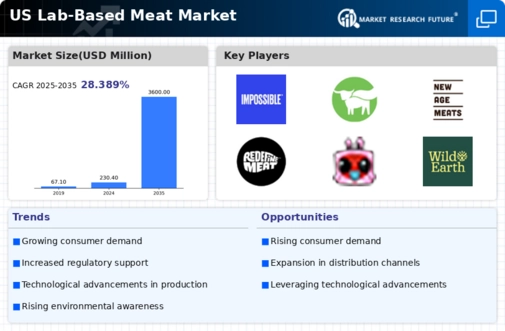Health Consciousness and Dietary Shifts
Health consciousness is a significant driver in the lab based-meat market, as consumers increasingly seek healthier dietary options. The rise in plant-based diets and the reduction of red meat consumption are indicative of a broader trend towards health-oriented eating habits. Lab based-meat products are often marketed as healthier alternatives, offering lower fat content and the absence of antibiotics and hormones commonly found in conventional meat. This shift in dietary preferences is supported by data indicating that 60% of consumers in the US are actively trying to reduce their meat intake. As health awareness continues to grow, the lab based-meat market is likely to expand, catering to the evolving needs of health-conscious consumers.
Sustainability Concerns Driving Innovation
The lab based-meat market is increasingly influenced by sustainability concerns among consumers and businesses alike. As awareness of environmental issues grows, there is a notable shift towards alternatives that reduce carbon footprints and resource consumption. Lab based-meat production is perceived as a more sustainable option compared to traditional livestock farming, which is associated with high greenhouse gas emissions and land use. According to recent studies, lab based-meat could potentially reduce land use by up to 90% and water consumption by 80%. This growing emphasis on sustainability is likely to propel innovation within the lab based-meat market, as companies strive to develop products that align with eco-conscious consumer preferences.
Investment and Funding in Alternative Proteins
Investment and funding in alternative proteins, including lab based-meat, are rapidly increasing, reflecting a growing recognition of the market's potential. Venture capital firms and food industry stakeholders are increasingly directing resources towards startups and companies focused on lab based-meat innovation. In 2025 alone, investments in the lab based-meat market reached approximately $1.5 billion, indicating strong confidence in its future. This influx of capital is likely to accelerate research and development efforts, leading to the introduction of new products and technologies. As funding continues to flow into the lab based-meat market, it is expected to enhance competitiveness and drive further growth in the sector.
Technological Advancements in Cultivation Techniques
Technological advancements play a crucial role in the lab based-meat market, particularly in the development of cultivation techniques. Innovations in cellular agriculture and bioprocessing are enhancing the efficiency and scalability of lab based-meat production. For instance, recent breakthroughs in tissue engineering have enabled the production of lab based-meat that closely mimics the texture and flavor of traditional meat. This technological evolution not only improves product quality but also reduces production costs, making lab based-meat more accessible to consumers. As these technologies continue to advance, the lab based-meat market is expected to witness significant growth, with projections indicating a potential market value of $25 billion by 2030.
Changing Consumer Preferences and Ethical Considerations
Changing consumer preferences, particularly regarding ethical considerations, are driving the lab based-meat market. Many consumers are increasingly concerned about animal welfare and the ethical implications of conventional meat production. Lab based-meat offers a solution that aligns with these ethical values, as it eliminates the need for animal slaughter. Surveys indicate that approximately 70% of consumers are willing to try lab based-meat if it is marketed as a humane alternative. This shift in consumer attitudes is likely to foster greater acceptance and demand for lab based-meat products, thereby contributing to the market's expansion. As ethical considerations become more prominent, the lab based-meat market is poised for growth.






















Leave a Comment